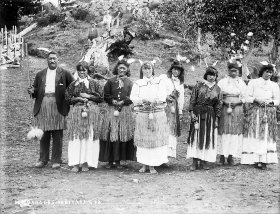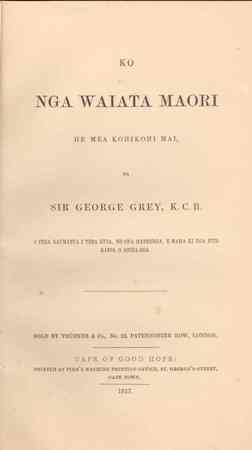 Reference number: 1/1-012050-G, Alexander Turnbull Library. | Ko nga Waiata Maori, [by] Sir George Grey (1857)
Introduction |
| Waiata pages : 3-8 | 9-13 | 13-18 | 19-23 | 23-27 | 28-36 | 36-47 | 47-57 | |
 | Ko Nga Waiata Maori he mea kohikohi mai, i tera kaumatua i tera kuia, no ona haerenga, e mahi ki nga pito katoa a Aotea-roa, collected by Sir George Grey, was sold in London in 1857 by Trubner and Co. It was printed at Pike's Machine Printing Office, in Cape Town. Because of the rarity of the Library's original copy, a digitisation process has allowed us to present the book in an electronic format. Note that the spelling and grammar used by the publisher has been retained in this on-line version. Some of the spellings used were written phonetically or are based on incorrect interpretations of a spoken word. Ko Nga Waiata Maori was not an illustrated publication. Illustrations have been presented from a variety of sources to accompany the text and connect Grey's work of gathering and collating the waiata. Additional notes have also been added to individual waiata where other information is available in published sources. The order of the waiata follow the original publication.
His interest in Maori literature is explained in his own words as follows : - "I soon perceived that I could neither successfully govern, nor hope to conciliate, a numerous and turbulent people with whose language, manners, customs, religion, and modes of thought I was quite unacquainted.... I could not as Governor of the country, permit so close a veil to remain between myself and the aged and influential chiefs whom it was my duty to attach to the British interests and to the British race, whose regard and confidence, as also that of their tribes, it was my desire to secure, and with whom it was necessary that I should hold the most unrestricted intercourse. Only one thing could under such circumstances be done, and that was to acquaint myself with the ancient language of the country, to collect its traditional poems and legends, to induce their priests to impart to me their mythology, and to study their proverbs. For more than eight years I devoted a great part of my available time to these pursuits" Preface to Polynesian mythology, by George Grey. See more information about Sir George Grey below. |
|
Sir George Grey, 1812-1898 is believed to have been born in Portugal, 1812, just after his father died in the Napoleonic war. He was educated in England, became a soldier 1830-36 before undertaking expeditions of exploration in Australia in 1837-39. Grey with his wife Eliza, went briefly to England before returning to South Australia as Governor. Grey was appointed Governor of New Zealand in 1845-53, and enjoyed great mana with the Maori people. He moved to South Africa in 1854 but returned to New Zealand in 1860 in an attempt to defuse disputes in Taranaki arising from the Waitara land purchase. Because of his headstrong policies, his position as Governor was terminated by the British government in 1868. After a short sojourn in England he returned to New Zealand to live on Kawau Island and eventually entered politics, become premier in 1877 but resigned from that position in 1879. Grey returned to England in 1894, resigning his seat in 1895, reconciled with his wife in 1897, but they both died in England in 1898. "He (Grey) took a scholarly interest in Maori language and culture. He was the author of Ko nga mahinga a nga tupuna Maori, London 1854; Ko nga moteatea, me nga hakirara o nga maori, Wellington, 1853; Ko nga waiata maori, Cape Town and London, 1857" (Keith Sinclair (1990) writing in Dictionary of New Zealand Biography, Vol 1") | |
![Mundy, Daniel Louis, 1826?-1881 (photographer) :[Sir George Grey. ca 1860].Reference number: G-623. used with kind permission from the Alexander Turnbull Library.](greycover.jpg)
